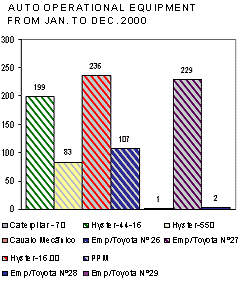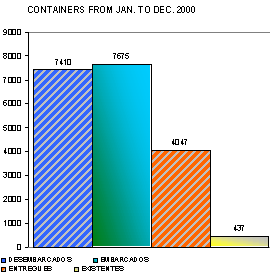
 PORT OF LOBITO: ANGOLA'S CHIEF PORT PORT OF LOBITO: ANGOLA'S CHIEF PORT |

The Port of Lobito is located 400 kilometers to the south of Luanda, on Lobito Bay, an arm of the Atlantic Ocean, near the city of Benguela. Lobito is the ocean terminus of the important Benguela Railway. In 1903 Lobito started the construction of its Port.
It was the construction of the Port that provided the conditions for the unloading operations of the materials destined to the construction of the railway (over 1300Km long), crossing the plains and ending at the border of Luau, East of Angola. The objective was a subsequent connection to the transafrican railway network shortening the distance between the Atlantic and Indian Ocean. Thus, the movement of northbound merchandise destined to Botswana, Zimbabwe and Tanzania, and the minerals of Shaba (Democratic Republic of Congo, ex-Zaire) coming south, was made possible.

The Port of Lobito dignifies Angola. Its present status as the main Port of the province is due to both coastal and international trade, both small and large vessels, and is considered, by World Navigation, to be one of the best ports on the African Continent.
 Here lies the future Here lies the future |

New computer systems are being implemented to accelarate the work and, in order to further promote the Port of Lobito, it has been decided to use the dynamics that new technologies offer. The creation of our website makes it possible to publicise the recent innovations, and the variety of services now offered.

 NAVIGATION NAVIGATION |

The Port of Lobito is located on the West Coast of Africa at 12º 20'47" degrees latitude South and at 13º 32'45" degrees longitude East. The anchorage of the Port is approximately 5,2 kms long and ranging from a width of 300 m at the entrance to 2000 m at the widest part, with a total area of about 6 km². The magnificent conditions of the bay, the excellent organisation and technical equipment guarantee absolute ease for vessels of small and large draughts, both on short and long routes.
The depths vary between 10.5m and 34m relating to zero sea level, allowing the simultaneous docking of six ocean-going vessels. The high tide and low tide levels reach between 2m and 0,20m respectively. Tide Table
The distance from the Port of Lobito to Cape Town (South Africa) is 1410 miles, New York (USA) 7537, Amsterdam (Holland) 5127, Southampton (England) 5050 and Lisbon (Portugal) 4197.
The piers used by ocean-going vessels are L shaped with a total length of 1124m.
One of the piers, situated towards the sandbank, normally known as "North Dock", is 572m long.
The other, perpendicular to the first one, called the "South Dock", is 552m long. The quay walls for the ocean-going vessels are of two different types: continuous and discontinuous, with pillars distanced at 15m, on the remaining part of the docks. Tropical climate with an average annual temperatures of 20º degrees centigrade. Two well-defined seasons - the summer or rainy season (September to April), and the "cacimbo" mist (May to August) influenced by the cold current of Benguela.
 SERVICES SERVICES |
 1. EQUIPMENT: 1. EQUIPMENT: |
Two powerful tugboats of 5000 HP and 2800 HP facilitate the mooring and unmooring of vessels. We have one floating crane with the following characteristics: Minimum cargo capacity of 120 TONS and maximum 150 TONS with a reach of 12 metres. Lift height maximum: 25 metres in relation to the water level.

Engines: 2 Diesel with 6 cylinders of 132 HP. For water supply there is a vessel named "Albacora" with a capacity of 100 TONS. Cable laying launch named "DACK DOY", equipped with radar, VHF and sonar. For loading and unloading merchandise onboard vessels, there are 28 electric cranes and container cranes of diverse makes with capacities varying between 3 TONS and 22 TONS. There are four machines of 27 and 48 TONS, to facilitate container handling.
The Port of Lobito has 15 machines with lifting capacities of 2,5 TONS and 5 TONS.
We have one with a capacity of 7m³ and one of 1m³ to support various services, such as the handling of bulk cargo inside the holds. There are two dumper trucks with a capacity of 17 TONS each. To support various services, the Port has 6 tractors with a traction capacity of 20 TONS each, and equipped with shock pump.

We have a total of approximately 25 km of railway lines in the Port area. There are 4 diesel locomotives for the service of the Port of Lobito maker COCKERILL of 360 HP (one single 8 cylinder engine). Apart from the locomotives there are also 7 wooden wagons and 29 metal wagons: 19 with highboard, 32 TONS capacity, and 10 lowboard, capacity of 30 TONS each. The Port area is served by railway lines, with track distance of 1.067m, connected to Benguela Railway Service by two entrances, one of which is through a small sorting station.
There is one LORAIN with a capacity of 150 TONS for our clients' use. For the service of our clients, there are 6 reverse diggers with several terminals.
 2. STOWAGE: 2. STOWAGE: |
The development of international commerce and technical utilisation in the handling of loading and unloading merchandise in Ports demands continuous modernisation. Consequently, the Port of Lobito has rapid and efficient Stowage Service, reaching an average of 1800 Tons per day per vessel.
|
 3. CARGO HANDLING FACILITIES: 3. CARGO HANDLING FACILITIES: |
The Port of Lobito has a modern terminal for refrigerated containers with a storage capacity of 64 containers, responding to all demands in respect to the conservation of agricultural and perishable products.

Approximately in the centre of the South Dock are the cereal silos with a storage capacity of 25000 Tons, made up of 53 cells: 32 of 550 Tons., 7 of 200 Tons. and the remainder of 170 Tons.The silos are equipped with a mechanical device permitting the loading of vessels at an average of 400 Tons/hour.
In the Port area, located at the end of the South Dock, there are two terminals for the reception of bunkers destined for the Sonangol facilities.
There are ten refrigerated chambers on the second floor of warehouse Nº1, five of which are for positive temperatures (normally + 3º C) and the remainder for negative temperatures (from - 16º C to - 18º C). The capacity of each chamber is 100/120 m³.
There is an extensive Port area for open air storage for the rest of the merchandise, offering all conditions for a large number of containers and minerals in bulk.
There are 17 warehouse in the Port area, of which the four largest ones are:
| Nº |
Area / m² |
Height / m |
| 22 |
3654,54 |
5,10 |
| 20 |
3221,40 |
6,5 |
| 19 |
2324,56 |
6,1 |
| 18 |
1784,93 |
5 |
 4. NAVIGATION SUPPLY: 4. NAVIGATION SUPPLY: |

Alongside the dock, for ocean-going vessels, there are 34 hydrants for water supply; 17 on north dock and 17 on south dock. The output per hour, theoretically, is 20m³. However this average is obviously conditioned by the city water supply. The types of fuel that can be supplied are Fuel Oil and Diesel Oil. This supply is furnished at an average of 45000 m³ per hour, with an installed capacity of 210000m³ / per hour. For the supply of electricity, the Port of Lobito uses two generators of 1500 and 1200 KVA (with high power factor). These respond to all demands.
 5. SAFETY AND SECURITY: 5. SAFETY AND SECURITY: |
The Port's administration considers safety to be of major priority, proof of this being the existence of two lighthouses at the entrance of the bay, and photovoltaic buoys to mark the navigational channel. As a result all manoeuvres may be made in safety at any time of day or night.
The launches also play a fundamental role in patrolling the area under jurisdiction, therefore guaranteeing all users total tranquillity in the performance of their functions.
To ensure the proper function of Port infrastructures, navigation, merchandise and maritime workers, the Port has its own security personnel commanded by Sr. Comandante Francisco Albano.
The security service is equipped with the most modern means of communications and is backed by the National Police, operating both inside and outside the Port area. To complete the safety structure, we would also like to point out the excellent fire equipment existing in the Port installations, prepared to face any situation.

 PERSONNAL AND WORKING HOURS PERSONNAL AND WORKING HOURS |
The organisation of labour consists of a total of 1320 workers, made up of 168 persons of responsibility: 3 first class technicians, 15 second class technicians, 13 medium grade technicians with similar skills, 50 basic grade technicians, 272 administrative and service staff and 789 operators.
The service continues uninterrupted as determined by the demands and necessities of production. The normal hours of work are from 7.30 am to 5.00 pm, with a lunchbreak between 12 noon and 1.30 pm.
The following dates are considered to be Public Holidays in the Port of Lobito: January 1st and 4th, February 4th, March 24th, May 1st, June 1st, September 2nd and 17th, November 2nd and 11th, December 25th. Carnival and Good Friday.

 SUPPORT STRUCTURES SUPPORT STRUCTURES |
The Company owns a transit lodge giving support and technical assistance to the Port.
Airport: 33 Kms from Benguela with an aero-taxi service.
Full hotel network with categories of up to four stars.
More than twenty Navigation and Transit Agents.
Medical assistance supplied by two municipal hospitals and one provincial.
Commercial Banks and Foreign Exchange.
 A NATURAL PORT OF DEEP WATERS. EASY SIMULTANEOUS BERTHING OF VESSELS AT EVERY HOUR OF THE DAY. A NATURAL PORT OF DEEP WATERS. EASY SIMULTANEOUS BERTHING OF VESSELS AT EVERY HOUR OF THE DAY. |

1. LIGHTHOUSES LOCATED AT THE ENTRANCE OF THE PORT ALLOW SAFE BERTHING DURING THE NIGHT.
2. CHANNEL BUOYS EVEN WITH THE EXISTENCE OF LIGHTHOUSES, THE LIT BUOYS SHOW THE PORT NAVIGATION CHANNEL.
3. QUAY N. 1. LENGTH: 570 M, DEPTH: 10.36 M AT LW. ORIENTATION: NORTHEAST / SOUTHWEST (053 / 233).
4. QUAY N. 2. LENGTH: 552 M, DEPTH: 10.36 M AT LW. ORIENTATION: NORTHWEST / SOUTHEAST (143 / 323). |

